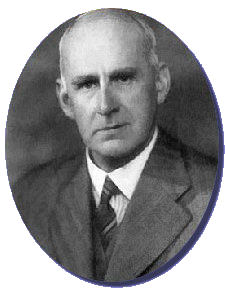 Arthur Stanley Eddington (1882-1944) was one of the foremost
astrophysicists of the twentieth century, making fundamental contributions to
our understanding of general relativity, as well as the internal structure of
stars and the method by which they generate energy. His text "The Internal
Constitution of the Stars" is notable not only for its fluid prose, but its
far-reaching implications for the development of stellar astrophysics. The famous
"mass-luminosity relationship," which describes the relationship between a
healthy star's mass and its intrinsic brightness, was devised by this brilliant
scientist.
Arthur Stanley Eddington (1882-1944) was one of the foremost
astrophysicists of the twentieth century, making fundamental contributions to
our understanding of general relativity, as well as the internal structure of
stars and the method by which they generate energy. His text "The Internal
Constitution of the Stars" is notable not only for its fluid prose, but its
far-reaching implications for the development of stellar astrophysics. The famous
"mass-luminosity relationship," which describes the relationship between a
healthy star's mass and its intrinsic brightness, was devised by this brilliant
scientist.
Lifetime Cycling Progress
When not doing astrophysics, Eddington was an avid cyclist, taking long tours of England each spring and fall. He kept track of all his routes by tracing them on a large map, and devised a criterion for tracking lifetime cycling progress. This criterion was the largest integer n such that one had cycled at least n miles on n different days. This idea was brought to my attention by Dr. Richard Wade, one of my thesis committee members, during my graduate school days at Penn State. Below are two extracts from Eddington's letters to Subrahmanyan Chandrasekhar, quoted by the latter in Eddington: The Most Distinguished Astrophysicist of His Time (1984, Cambridge: Cambridge, p. 6).
My cycling n is still 75. I was rather unlucky this Easter as I did two rides, seventy-four and three-quarters miles, which do not count; I still need four more rides for the next quantum jump. However, I had marvellously fine weather and splendid country, chiefly South Wales (July 4, 1938).
n is now 77. I think it was 75 when you were here. It made the last jump a few days ago when I took an eighty mile ride in the fen country. I have not been able to go on a cycling tour since 1940 because it is impossible to rely on obtaining accommodations for the night; so my records advance slowly (Sep 2, 1943).
The second quotation is not only a commentary on the state of the world in 1943, but also shows that Eddington was riding 80 miles or more at age 61, not much more than a year before his death.
The criterion Eddington devised is simple but interesting. For example, you could achieve a number of 30 by doing thirty 30-mile rides. But as far as n=31 was concerned, it would be as if you had never ridden a single mile. The criterion encourages you to plan routes, taking loops to get extra distance that provides "credits" toward higher numbers. Instead of doing the 30-miler, you might explore the far side of one more hill to push the distance up to 37 miles; then you'd get one credit toward numbers 31 through 37, as well as any below 31 that you hadn't yet reached. And with n=30, if you do a 29-mile ride, you don't get any additional credits at all. (Today, scientists publishing papers and being cited by their peers might find this a bit familiar.)
My Eddington Number
Certainly Eddington did not refer to this quantity as the Eddington Number; however, I think it's a fitting title and I refer to it by the letter E. During graduate school, I reached an E of 27, but in moving to Arizona in 1992, I lost my records. What to do?
If I were sending a paper to a research journal on this topic, I might write: During system hardware relocation, a technical problem was encountered, resulting in major data loss. However, this has been demonstrated to have negligible impact on the program; by employing the statistical reconstruction algorithm of Sammartini and Vermicelli (1979), we have been able to recover the Eddington number, finding its value to be 27.2 +/- 29.0.
Or, I can base the number on hard data and start over. Which is what I did, and my new current E is back to 28.
[ Back ]